Membrillo (Sweet Quince Paste)
This post may contain affiliate links. See my disclosure policy.
Popular throughout many countries, membrillo (aka, quince paste or quince cheese) is incredibly versatile and one of the most delicious confections you’ve ever tasted! It also makes an excellent and unique gift for friends and family who appreciate good food. This membrillo recipe is easy to make and freezes well so you can conveniently have it on hand whenever you have friends over or are in the mood for a delicious snack!
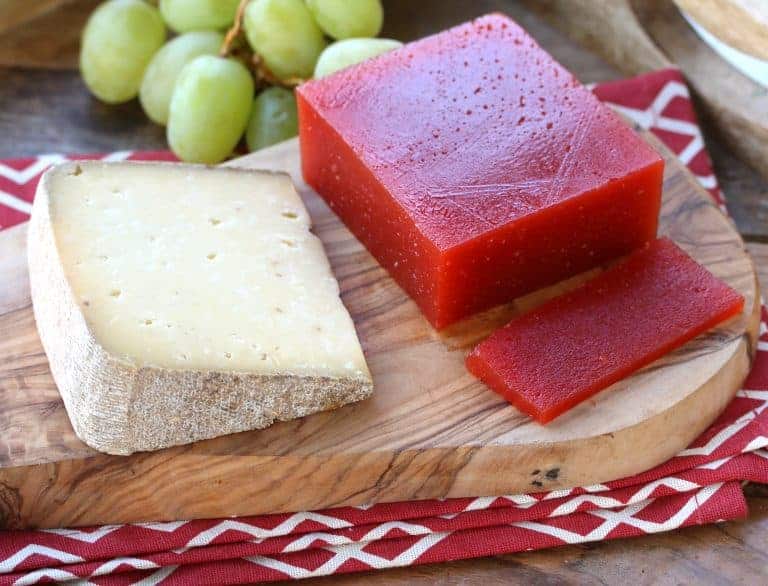
What is Quince?
The quince fruit has been prized since ancient times and up until around the early 19th century was still found in the garden of many homes. As long ago as 1922, the great New York pomologist U. P. Hedrick rued that “the quince, the ‘golden apple’ of the ancients, once dedicated to deities, and looked upon as the emblem of love and happiness, for centuries the favorite pome, is now neglected and the least esteemed of commonly cultivated tree-fruits.”
Though highly revered for so long, it has sadly fallen out of favor to the point where few people have even heard of it let alone tasted one. How that happened I can’t imagine because it is one of the most under-appreciated and spectacular fruits out there.
Though it is in the same family as apples and pears, the quince is practically inedible raw, no matter how ripe, and has to be cooked. And though it is considered less versatile than apples and pears, and is challenging to find anymore, it has such an incredible and unique flavor it is worth every effort to find it.
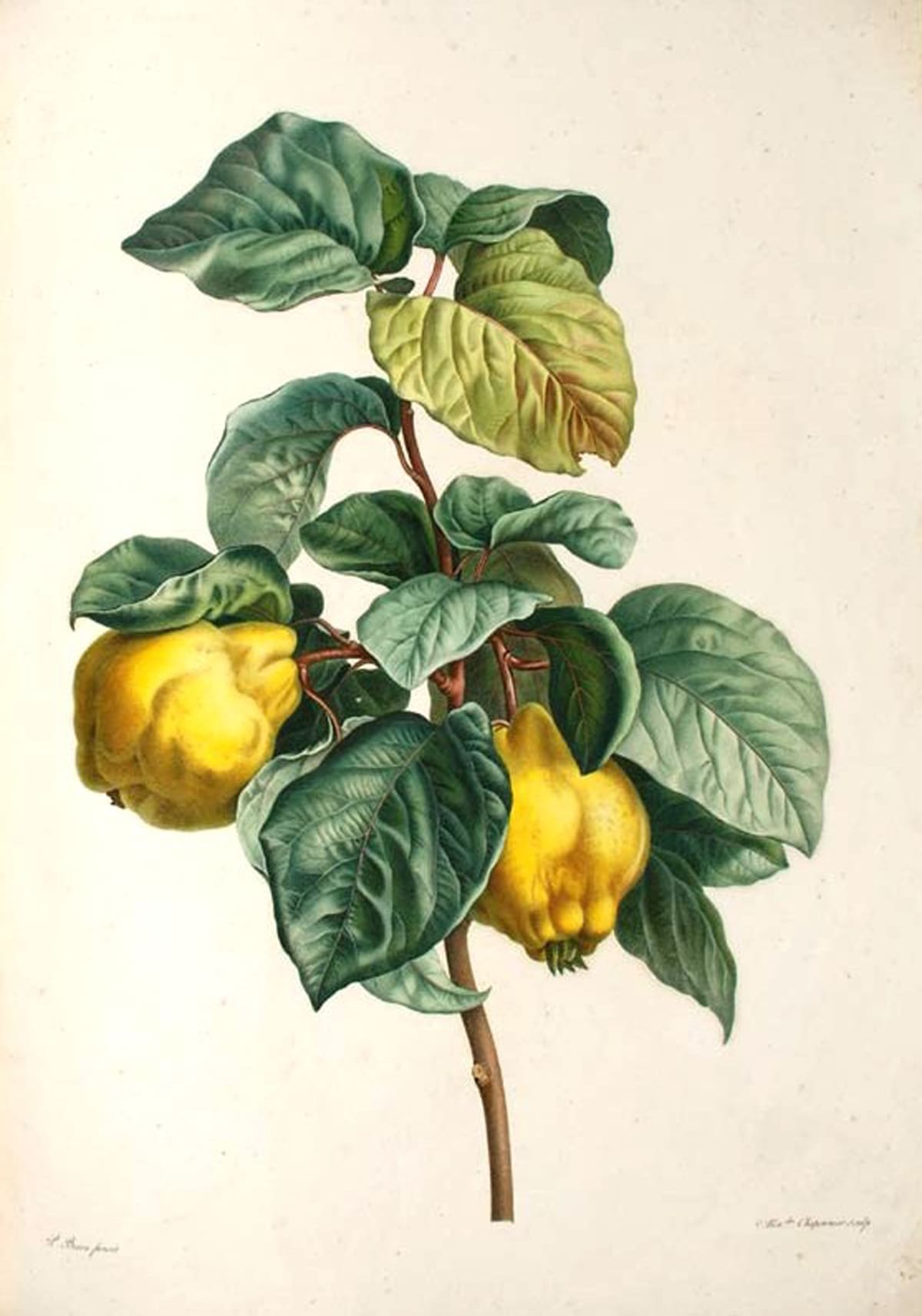
Some grocery stores carry it during the Christmas season but you’ll likely need to ask the produce manager to order some for you. My solution was to plant a quince tree a couple of years ago and eagerly look forward to the first fruits next year!
Today we’re making what is probably the most famous application of the quince besides quince jelly: Membrillo.
What is Membrillo?
Membrillo is a sweet, thick, sliceable firm paste made from quince that originated in Spain and is especially popular during the Christmas holidays. It is now a popular confection in many countries. It’s also known as Dulce de membrillo (Spain, Ecuador, Argentina, Chile, Mexico, Uruguay), marmelada (Portugal, Brazil), pâte de coing (France), Quittenkäse (Germany), birsalmasajt (Hungary), and quince cheese (New England) or quince paste (UK, Canada, Australia), to name a few.
The quince has been a highly revered fruit since ancient times and this recipe is thought to have Roman origins as early as the 4th or 5th century AD and used honey instead of sugar.
Quince paste is usually sold in squares and is served by cutting it into thin slices to accompany cheese (in Spain, membrillo and manchego cheese are inseparable), served on crackers, spread on toast or sandwiches, served with breakfast, eaten plain as a sweet confection (and commonly rolled in sugar), served with meats, and is also used to stuff pastries and spread in cakes.
I’ll never forget the first time I tried membrillo. It was also the first time I had ever tried quince. Oh, the aroma and the flavor! It’s among the most unique and wonderful smells and flavors I’ve encountered. It’s hard to describe. It’s not anything like apple or pear. The best word I can think of to describe the flavor is sweetly floral. It has a highly aromatic, floral flavor, almost like it’s made with essential oils of wild English roses. After having tasted quince, I now understand why quince in ancient times was considered a fruit of the gods. It is divine.
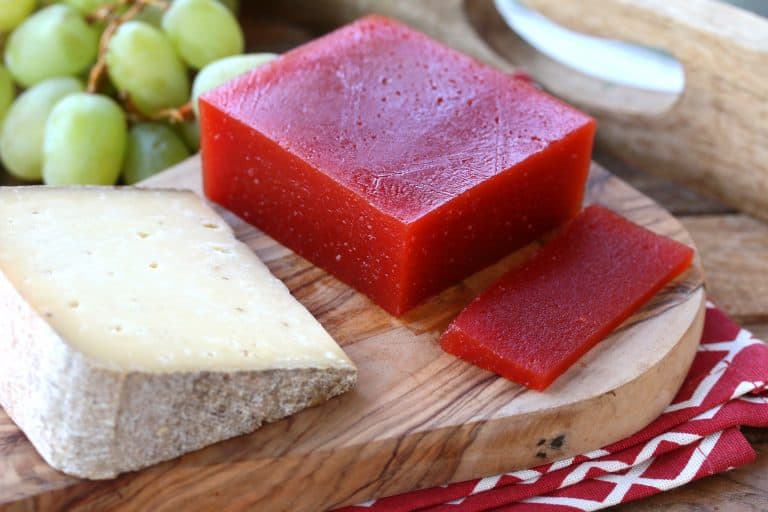
How to Make Membrillo
Making membrillo is extremely easy. Many recipes call for cooking the quinces whole, then straining the water, then peeling and coring them, then weighing the pulp and then simmering it with sugar. None of that extra fuss is remotely necessary.
First of all, the quince flesh itself is so high in pectin that simmering it with the peels and seeds is unnecessary. Not only that, leaving the skins on will result in a membrillo that is slightly browner in color. Just peel and core your quinces from the start and throw the diced quince directly into the pot with the sugar and water. Secondly, there is no need to strain the water and then weigh the pulp. Simply weigh the peeled, cored quince at the start and add it to the pot with the sugar and a little water. Stew the quince and then simply puree the mixture and let it set. That’s it. The result will be a firm membrillo with a perfectly sliceable consistency and heavenly flavor!
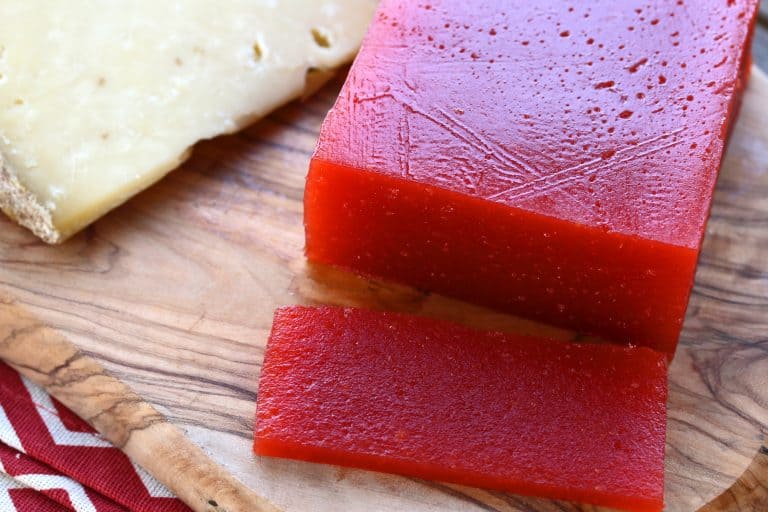
How Long Does Membrillo Keep?
Membrillo keeps for a long time, which is a big plus. Like jam, the sugar acts as a preservative and it will keep in the fridge for at least 3 months. In many areas of the world it’s kept at room temperature for the same length of time. It also freezes well for even longer storage.
How to Serve Membrillo
Membrillo is typically served at room temperature sliced or cubed. It’s often served as an appetizer or dessert and is paired with cheese, crackers or bread or as part of a cheese and charcuterie board. Serve membrillo with hard and semi-hard cheeses like Manchego, a classic pairing.
Alternatively, membrillo can also be used as an ingredient in various dishes, such as a filling for tarts and pastries, or as a glaze for meats.
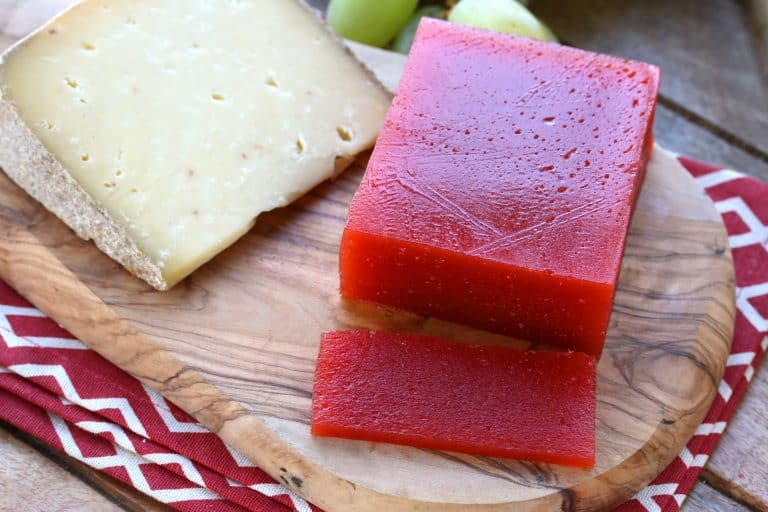
Membrillo Recipe
Let’s get started!
Select ripe, fragrant quinces.
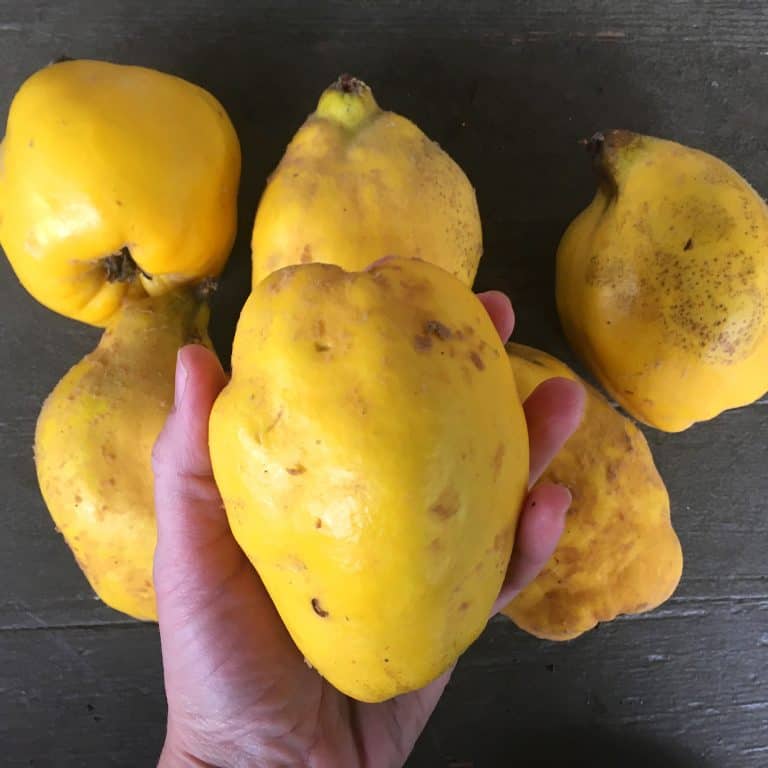
Wash and remove any of the fuzz from them. Peel and core the quinces and dice into 3/4 inch pieces.
They will turn brown quickly, that is perfectly okay.
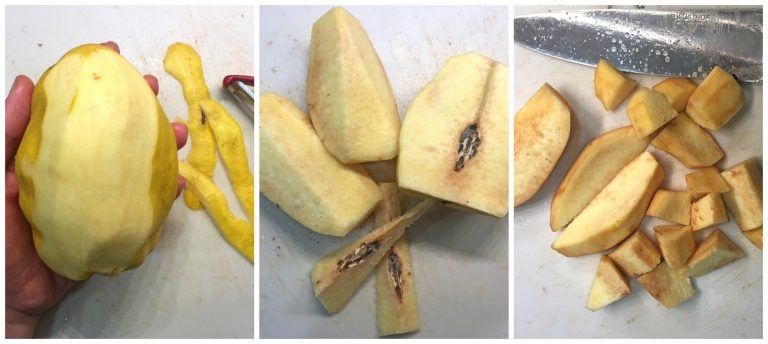
Place the diced quince in a medium pot over medium heat along with the sugar, lemon juice and water.
Bring the mixture to simmer, stirring occasionally to melt the sugar.
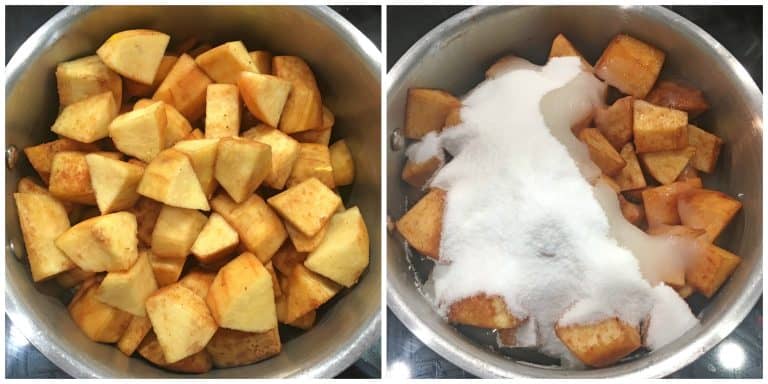
Continue to simmer over medium heat for an hour or so, stirring occasionally.
During this time the quince will progressively turn into a beautiful ruby red color.
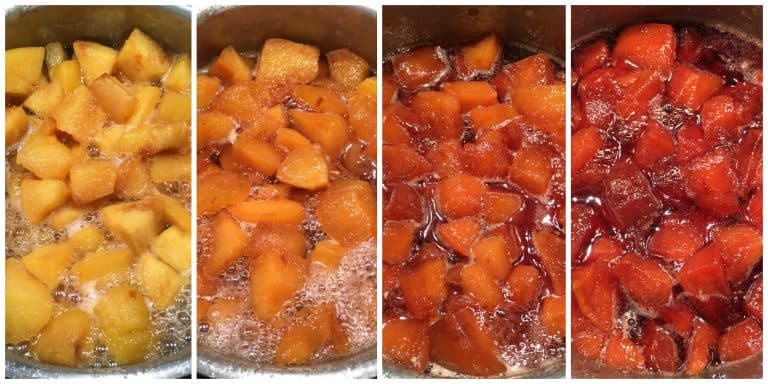
Simmer until a candy or instant-read thermometer reads 220 degrees F. This doesn’t always guaranteed it’s ready, so at this point also do a plate test to make sure the mixture is done: Spoon a little of the liquid onto a cold plate and wait a couple of minutes. Push the liquid with your finger and if it wrinkles it is ready. If it doesn’t, continue to simmer and re-test.
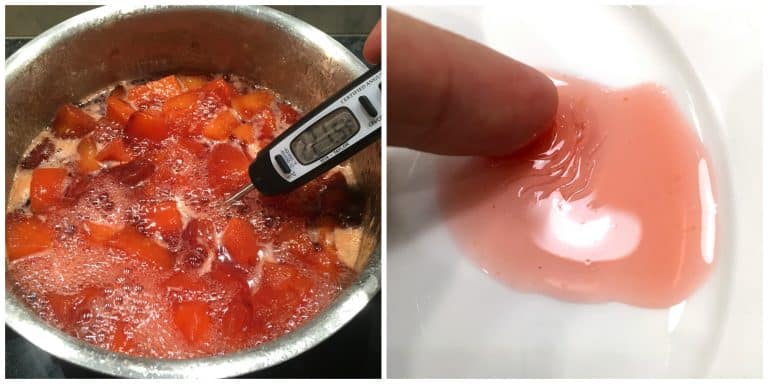
Grease a 8×8 inch glass baking dish.
Puree the mixture with an immersion blender or blend in a Vitamix or similar until smooth.
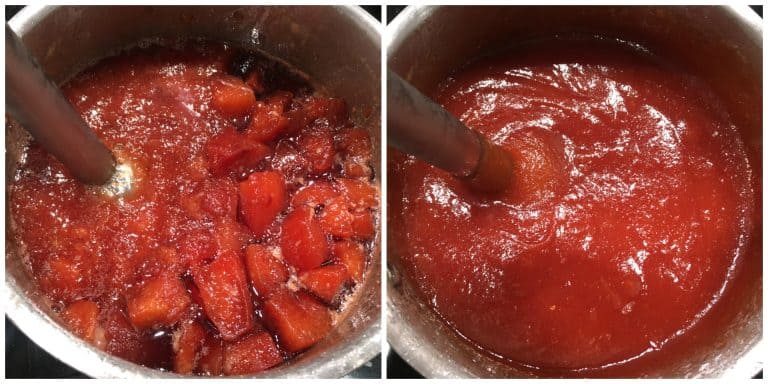
I find the immersion blender is adequate but if you want the mixture even smoother, transfer it to a Vitamix (or similar).
Pour the hot mixture into the greased baking dish.
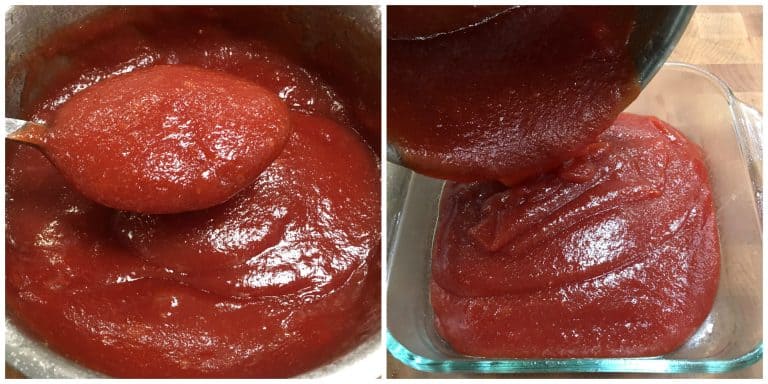
Use the back of a spoon to smooth the top. Let it cool to room temperature, then cover with plastic wrap and refrigerate for 24-48 hours until firm. Invert the membrillo / quince paste onto a platter (you may need to gently pry it out with a knife).
Note: Some recipes call for placing the membrillo in an oven at low temp (125 degrees F) for 8+ hours to firm it up. This membrillo is already firm and perfectly sliceable. If you prefer it even firmer, proceed with dehydrating it.
Cover with plastic wrap and store in the fridge for up to 3 months or longer. For longer storage membrillo can be frozen well-wrapped for up to a year.
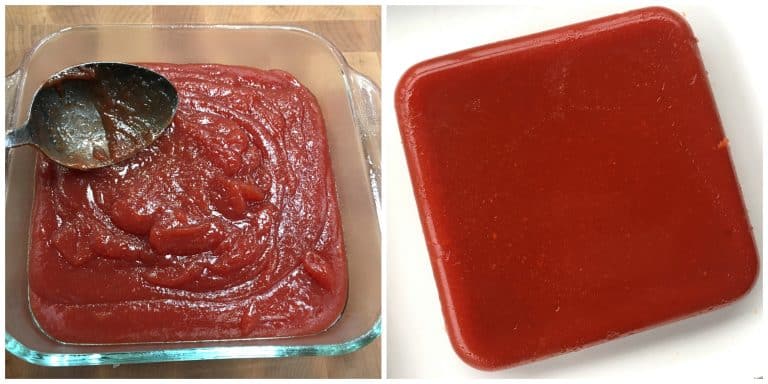
Enjoy!
Serve with your cheese & charcuterie board. Traditionally served with manchego but pairs beautifully with most aged, hard cheeses.
Alternatively, you can also cut the membrillo into small squares and dehydrate them at low temp for a while in the oven to firm them up, then roll them in sugar as a sweet confection.
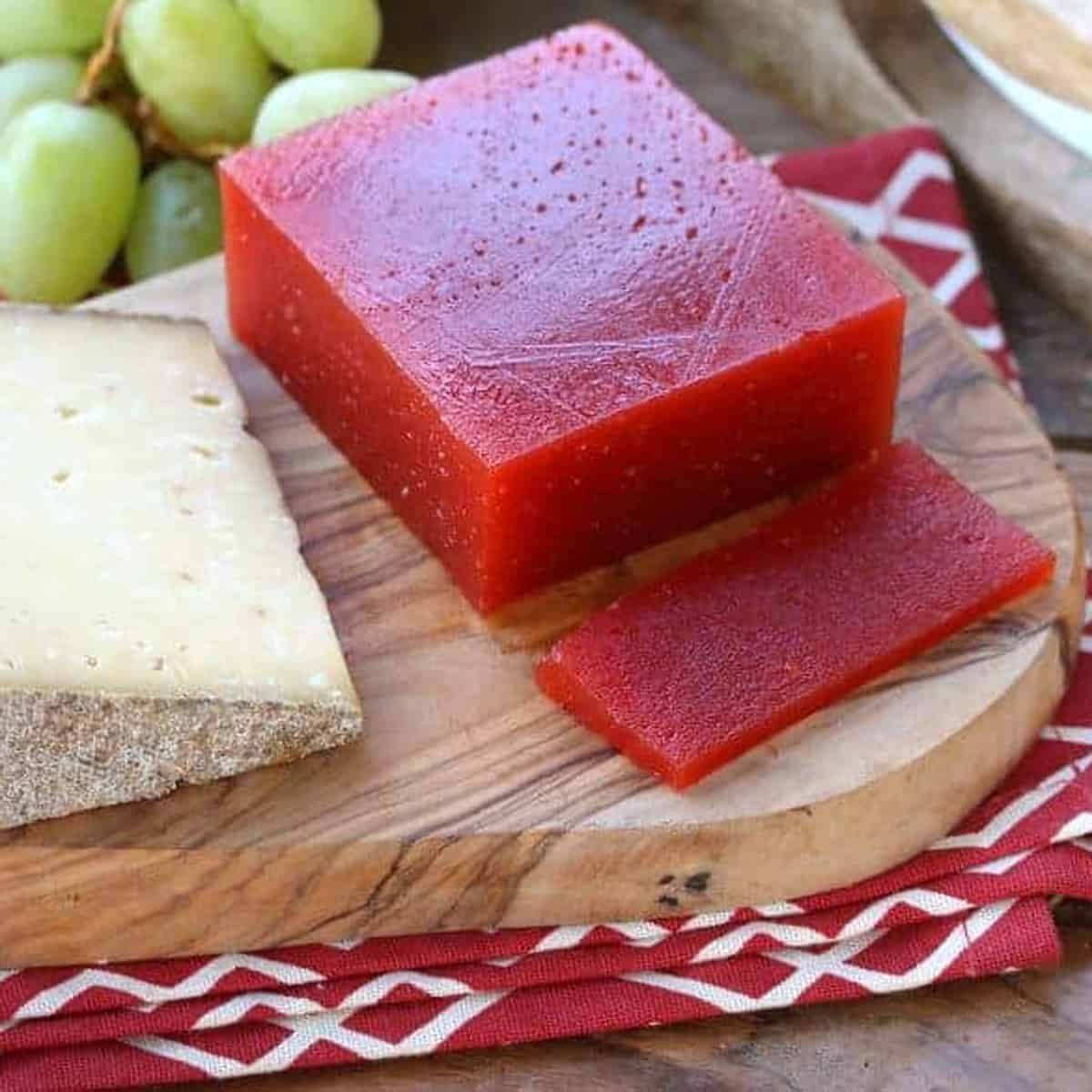
For more delicious recipes to feature on your cheese and charcuterie board, be sure to try my:
- Chicken Liver Pate
- Capicola
- Toasted Hazelnut and Date Spread
- Black Olive Tapenade
- Pork Rillettes
- Smoked Salmon Spread
- Pimento Cheese
- Pickled Asparagus
- Pickled Pepperoncini Peppers
- Pistachio Lemon Cheese Balls
- Creole Mustard
- How to Create a Cheese and Charcuterie Board
Save This Recipe
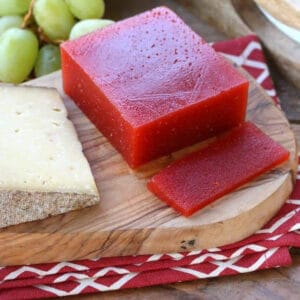
Membrillo (Sweet Quince Paste)
Ingredients
- 2.25 pounds quince , washed (remove any of the fuzz), peeled, cored and diced in 3/4 inch chunks (total weight is *after* peeling/coring) (if quince is unavailable, ask the produce manager if they can order it)
- 3 1/2 cups white granulated sugar
- 2 tablespoons lemon juice
- 1 cup water
Instructions
- Place all the ingredients in a medium pot over medium heat. Stirring occasionally, once the sugar has melted and the mixture begins to bubble, simmer uncovered for an hour or so, stirring occasionally, until the candy thermometer reads 220 degrees F. This doesn't always guaranteed it's ready, so at this point also do a plate test to make sure the mixture is done: Spoon a little of the liquid onto a cold plate and wait a couple of minutes. Push the liquid with your finger and if it wrinkles it is ready. If it doesn't, continue to simmer and re-test. The quince will increasingly change into a deep ruby red color.
- Grease a 8×8 inch glass baking dish. Puree the mixture with an immersion blender or blend in a Vitamix or similar until smooth. Pour the hot mixture into the greased baking dish and smooth the top. Let it cool to room temperature, then cover with plastic wrap and refrigerate for 24-48 hours until firm. Invert the membrillo / quince paste onto a platter (you may need to gently pry it out with a knife). Note: Some recipes call for placing the membrillo in an oven at low temp (125 degrees F) for 8+ hours to firm it up. This membrillo is already firm and perfectly sliceable. If you prefer it even firmer, proceed with dehydrating it.Cover with plastic wrap and store in the fridge for up to 3 months or longer. For longer storage membrillo can be frozen well-wrapped for up to a year. Makes one 8×8 inch square of quince paste.Serve with hard and semi-hard cheeses (Manchego is classic) and bread and crackers.
Notes
Nutrition
Originally published on The Daring Gourmet November 18, 2018



















I chose this recipe because it sounded so much quicker and easier than the way my grandmother and mother used to do it. For me it was not as advertised. The publisher must be very quick at prep; it took me twice as long. Then the cooking took 2 1/2 hours rather than 1 hour and even though I was stirring pretty constantly, it still burned a bit so I have black flecks in it. Hopefully it will set well! It does taste wonderful.
Excellent, clear instructions. Mine never did achieve a red color, but did set up nicely. I did add a few strips of peel as I knew that might help it get redder. They were easy to pull out before blending. I also wonder about quince varieties. My “Aromanataya” quinces are sweeter than most, and I think next time I will reduce the sugar just a bit. I had to add a lot more lemon.
Thank you, Mindz! Yes, there are several varieties of quince, each with varying levels of sweetness and slight color differences when cooked.
My house smells like a flower garden after cooking this!
Question though… My quince was bright red at 220 degrees until I blended it, when it turned pink. I thought maybe air got whipped into it, so I’m putting it back on the heat with a little more water (it’s very thick), but it’s still pink. Any suggestions?
Hi Angela, there are several quince varieties and there can be subtle differences in color, so I would base its doneness on the temperature, not the color.
First time that I cooked with quince… I have a tree full of them in my orchard. Tasted like a mix of pear and strawberry with a citrus finish… very unique. I could never get the temp to 220 as it started to burn. The color was a little deeper than that of ketchup. Now thinking of different ways to use the stuff :-) thanks for the recipe.
Recipe and instructions were excellent. I possibly simmered for a little longer than 1 hour – but the colour guidance photo and a jam thermometer ensured a perfect result. I didn’t have an 8×8 glass dish so I used a greased loaf tin instead and the effect is very pleasing – I can take a slice to have with whatever cheese I fancy! Thank you.
Fantastic, thank you so much Danielle!
I used this recipe for my first time and it worked out better than I expected even though I forgot to add the water.
Thank goodness for that! I’m so glad it was a success, Maggie, thanks for the feedback!
Maybe it was a lack of faith on my part, but 1 c water looked like it wasn’t going to last long enough for the fruit to turn red. I added more water, and for some reason (I think to make sure the fruit was at 220° was a factor) used a higher heat. The fruit got so soft I went ahead and mashed it while it was cooking. It was turning into a pretty solid paste. But it wasn’t turning colors and was starting to burn the bottom and side of the pan. On a whim I had started boiling the peelings and dumped the very hot water from that into the bowl. The heat from that water turned the fruit darker, each time a deeper orange-pink. I couldn’t get it to ruby red, and I couldn’t get it to congeal into a properly dense, membrillo consistency. Tasty jammy-with-body, though! Maybe next time I will follow the instructions… but really, 1 c water only??
Hi Jessica, yes it’s only 1 cup of water. Keep in mind the fruit will produce a lot of its own as it cooks down.
Hi,
My dad always made his memorial every year. When he first made it it didn’t look good. But, my dad insisted to taste it. So I did, I couldn’t stop eating his jam. I miss my dad and now I am going to try and make my own.I will try your recipe. My dad never told how he made it.
Rather than peeling, coring, and chopping the quince, I bake it. First I cut the fruit in half, lengthwise, and place it on a sheet of parchment with an added bit of water. I then cover the pan tightly with foil and bake at 350 degrees for about an hour, or until soft. I let it cool and dig out the flesh with my fingers.I puree this (or pass it through a food mill), weigh it, and add an (almost) equal amount, by weight, of sugar. I find that I need to cook it for two hours to get the right consistency – I stir with one hand, and read a magazine with the other!
Came out perfect and really tastey. Mine never went to ruby red, stayed more of a medium orange sunset color – does that mean I should have cooked it longer?
Hi Sharon, I’m so happy you enjoyed it, thank you! Yes, likely cooking it a little longer would have brought out a deeper color. Though it’s also possible that different varieties of quince will result in slightly different color variations.
Sharon, mine also came out more like sunset orange. I have made marmelade out of quince and it sometimes tastes to caramel vs. fruit forward when it’s a deep red, so I’m hoping this lesser colored paste will mean a more fruit forward flavor. It seems to have set well! But it’s cooling so I haven’t tasted it yet.
Thanks for recipe! Someone gave me a pound of Quince…and I only had lime… but it is tasty and in the fridge. Let the Holiday preparations begin!
I’m so glad, Laurie, thank you for the feedback!
This is a good recipe. However, you should know that quince has more naturally occurring pectin than any other fruit. That means it will set no matter what you do, and you’d be hard pressed to stop it setting! There is no need at all to bother with the jam setting test and frozen plate. You can safely skip that. I’ve been making quince paste, jam, and preserves for 20 years. This membrillo is a proper one, just skip the frozen plate.
Thank you, Jennifer, I’m glad you enjoyed it and thanks also for the feedback about the pectin!
Does it mean that, because of the high amount of pectin, that the sugar could be cut in the recipe without risking the consistency?
Thanks!
Pectin and sugar are two different setting agents. Imagine: savory vegetables in jelly (no sugar; pectin is the plant equivalent of gelatin) and imagine: sugar caramel decorations (no pectin). Both are rigid and set. You can reduce one of the two agents but to a certain limit only. Pectin is hardening by lowering temperature, caramel/syrup is hardening by drying. In membrillo both processes take place. One should practice how much to reduce sugar (still having a proper consistency), because there exists a successful potential. Pectin amount, fruit appearance and cooked fruit color depend on quince species (there are several species). Thank you, Kimberly, for your perfect recipe! Winter is a time for frozen quince processing.
Thank you for the compliment ,BeataR, and thank you also for sharing that helpful information!
I have not made this yet but plan in the next couple days. Can honey be substituted for the sugar? I want to share with a friend but she is allergic to sugar. I am excited to use this on a tray when I host Thanksgiving again this year. What else would you suggest pairing with?
Hi Deidre, I have not made this with honey so I cannot vouch for how that would turn out. Membrillo is served at room temperature sliced or cubed and is typically paired with cheese, crackers or bread. You can also include it as part of a cheese and charcuterie board.
I make it with honey – substitute 2/3 cup of honey for each cup of sugar, and omit the lemon juice as honey is noticably acidic.
It is absolutely delicious, but a bit pricey unless you keep bees…
We have a quince tree and have struggled with many recipes over the years and almost didn’t bother this year. I came across this page and decided to try it this weekend, and I just tasted the results. I’m very excited and happy report not only is this the easiest recipe we’ve tried, but the results are so much better! We have been talking about everything we can use our high quality membrillo for beyond charcuterie and I think we are even going to try using the same methods you’ve shown here for quince jelly! I appreciated your use of common sense to make the process less of time requirement, so a big warm thank you!!! Now I’m off to use some of this paste for a balsamic quince glazed chicken for Sunday dinner :)
That’s wonderful, Spencer, thank you so much! I’m so glad you decided to give it another go this year and that this was such a success. Thanks again for taking the time to leave feedback. And by the way, your chicken dinner sounds exquisite!
Made it today and the taste is perfect. I think I should have cooked it a little longer, but it seems to be setting well. Thank you!
Marla
Thank you so much for the feedback, Marla, I’m so glad you enjoyed it!